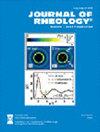Pyromali et al.: Nonlinear shear rheology of single and double dynamics metal-ligand networks
IF 3.2
2区 工程技术
Q2 MECHANICS
引用次数: 1
Abstract
We present a systematic experimental study of the shear rheology of metallosupramolecular assemblies based on entangled telechelic star polymers comprising one (single dynamic network) or two (double dynamics network) types of physical bonds with the aim to unravel the role of concentration and strength of these bonds on the nonlinear response. Model dynamic networks functionalized with terpyridine ligands were formed by adding different metal ions with increasing bonding strength, zinc, copper, and cobalt. The dynamics are driven by entanglement/disentanglement processes and a ligand exchange mechanism. Steady-state viscosities of single and double dynamics networks collapse onto a universal curve over a wide range of Weissenberg numbers based on terminal time (up to about 300 for single and 1000 for double), exhibiting stronger shear thinning (with an exponent of −0.76) compared to entangled neutral star polymers. Double dynamics networks consisting of two different metal ions (with different lifetimes) exhibit stronger mechanical coherence (rate-dependent fractional viscosity overshoot) and accumulate larger strain at steady-state flow compared to single-ion counterparts. The shear stress growth function signals exhibit weak, albeit unambiguous shear strain hardening, which becomes more pronounced for stronger associations. They also exhibit double overshoot, which reflects the interplay of association strength and chain deformation. Increasing the strength of associations leads to the failure of the Cox–Merz rule, which is more severe for single dynamic networks. The markedly different behavior of double dynamics networks is attributed to the fact that at sufficiently high ion content, the weaker bond acts as a sacrificial component, which provides local energy dissipation and enhances the overall deformability. This bears analogies with their linear viscoelastic response, which has revealed that the arm disentanglement (delayed due to the reversible bonds) effectively interpolates between the two single dynamic network components, depending on composition. Our results suggest ways to tailor the mechanical properties of this class of materials by judicious choice of the type and content of the ion.Pyromali等人:单动力学和双动力学金属配体网络的非线性剪切流变学
我们对基于纠缠远爪星形聚合物的金属超分子组装体的剪切流变性进行了系统的实验研究,该聚合物包括一种(单动态网络)或两种(双动态网络)类型的物理键,目的是揭示这些键的浓度和强度对非线性响应的作用。通过添加不同的金属离子(锌、铜和钴)来形成用三联吡啶配体功能化的模型动态网络。动力学是由纠缠/解纠缠过程和配体交换机制驱动的。基于终止时间,在宽范围的Weissenberg数上,单动态和双动态网络的稳态粘度坍塌为通用曲线(单动态高达约300,双动态高达1000),与纠缠的中性星形聚合物相比,表现出更强的剪切稀化(指数为-0.76)。与单离子对应物相比,由两种不同金属离子(具有不同寿命)组成的双动力学网络在稳态流动时表现出更强的机械相干性(与速率相关的分数粘度超调),并积累更大的应变。剪切应力增长函数信号表现出较弱但明确的剪切应变硬化,对于较强的关联,这种硬化变得更加明显。它们还表现出双重超调,这反映了关联强度和链变形的相互作用。增加关联的强度会导致Cox-Merz规则的失败,这对单个动态网络来说更为严重。双动力学网络的明显不同行为归因于这样一个事实,即在足够高的离子含量下,较弱的键充当牺牲组分,这提供了局部能量耗散并增强了整体可变形性。这与它们的线性粘弹性反应类似,后者表明,根据组成,臂的解纠缠(由于可逆键而延迟)有效地插入了两个单个动态网络组件之间。我们的研究结果提出了通过明智地选择离子的类型和含量来调整这类材料的机械性能的方法。
本文章由计算机程序翻译,如有差异,请以英文原文为准。
求助全文
约1分钟内获得全文
求助全文
来源期刊

Journal of Rheology
物理-力学
CiteScore
6.60
自引率
12.10%
发文量
100
审稿时长
1 months
期刊介绍:
The Journal of Rheology, formerly the Transactions of The Society of Rheology, is published six times per year by The Society of Rheology, a member society of the American Institute of Physics, through AIP Publishing. It provides in-depth interdisciplinary coverage of theoretical and experimental issues drawn from industry and academia. The Journal of Rheology is published for professionals and students in chemistry, physics, engineering, material science, and mathematics.
 求助内容:
求助内容: 应助结果提醒方式:
应助结果提醒方式:


